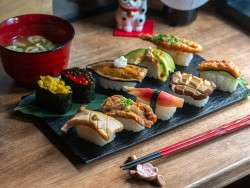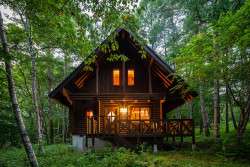
June 10, 2004
The Simple Life
City slicker Matthew Reiss takes a breather along Shikoku’s Shimanto River.
By Metropolis
Originally published on metropolis.co.jp on June 2004

Photos courtesy of Ehime Prefecture Tourism Office, Nakamura City Government
The Shimanto River moves slowly and our canoe paddles dip quietly, just noticeable enough to startle a pair of night herons. The elegant birds dive from their perch, catch a current of air and glide away side-by-side, a few feet above the water. Few experiences on the river exact greater excitement.
Indeed, Shikoku Island itself is a study in simplicity. Its greatest attractions have more in common with reading haiku than doing Disneyland. But if you’re coming from urban chaos or its outlying suburbs, it’s peace that you’re after anyway. To such a visitor, it’s just south of Nirvana.
Shore thing
Unlike Nirvana, however, you need a ticket to get there. Waiting for the train at Shin-Osaka, I join the buttoned-down salarymen before a giant TV monitor. The Red Sox are lashing the New York Yankees in my native Bronx, and I’m addicted to the tube as if it’s coffee or adrenaline. But this is a voyage to leave that all behind: an antidote for the loud, active and hectic life of that far-off metropolis displayed on the giant screen.
Matsui swings and misses, and the gravitational pull of New York City subsides. I descend to the tracks, find my seat and break from civilization at 250km/h. Cityscapes and power lines turn to hills and mountains and accompany me to Okayama, where a regional train rolls slowly off Honshu. We rumble onto a series of bridges and over the blue Seto Sea, and continue south to Uwajima.

A driver is waiting for me outside the hotel when the sun comes up to rush me into the coastal foothills of Ehime Prefecture, escorting me down the curving road that traces blue inlets of cultivated pearls and yellowtail tuna farms. At Uwakai Marine Park in Nishi Umi-cho, I transfer to a glass-bottom boat to trace the inlets more closely. When the captain spots an interesting seascape, he stops and lowers the viewing chamber. I glance out the thick glass window and find we’re idling in the middle of a school of horse mackerel that stretches at least a hundred meters. It’s all very nice, I tell my hosts, but I came to get a closer look. The captain folds up the hull and hustles us across the cove to Kashima Island.
Testing the waters
Slipping on rented flippers and secondhand goggles, I find my way along the rocks to a spot where I can enter the water. It’s slippery. And it’s cold. But not cold enough to deter me, even without a wetsuit. Paddling just a few feet from the rocks, I float over a bed of table coral that seems to spread several acres. My eyes focus on a tiny organism camping comfortably atop its flat, maroon-colored host: a jellyfish, transparent and smooth, with a pair of visible internal organs that give off an electric glow. I glide from table to table, staring into the innards of these otherworldly beings.
Back on shore, we briefly tour the stone village of Saiikaitro. It’s an image of another age, constructed along a hillside with large rocks and concrete to protect from typhoon winds. The vision is only interrupted by the occasional television antennae.
From there I’m hustled into a waiting car for a rushed drive to the banks of the Shimanto River. Hamada, my guide from the tourist office, tells me we’re running behind on a tight schedule but the speed of our trajectory along the narrow, winding roads does not disturb my feeling of leisure.
At the hamlet of Nishi Tosa we stop at the general store and recreation center to pick up the local river fish, udon and Hamada’s friend before heading into the hills. Atop the river’s steep banks at Momose An lies a 100-year-old minshuku or country inn. I trade my shoes for antique wooden sandals and light a fire under the cast-iron bathtub while my cohorts light another in the living-room fire pit, or irori.

We massage salt into river shrimp, aiyu, and the local trout species, and barbecue them alongside slender pork sausages, fresh chicken on skewers, an assortment of green vegetables and buttery-tasting Shimanto beef. Eating and drinking and bathing in the Goemon buro (bathtub) take up most of the evening, before we venture out to the local hotspot. A couple of glasses of shochu later, we set up camp in the living room and soon fall asleep under the minshuku’s heavy wooden beams.
The next morning we take a canoe trip down the Shimanto River. The river’s gentle current leaves the water as flat as plate glass, even as it bends around the hills and gorges that surround it. Absolutely free of industrial contamination, I am told, the river has provided 50 architects with the opportunity to construct bridges over it. “Each bridge has a name, a style and a feeling,” explains Hamada. With the foothills in the background, the best examples complement the topography with elegant simplicity.
As the sun begins to set over the river, I reflect on my brief visit. Cramming several views of Shikoku’s outback into a few days had allowed me a taste of the peaceful beauty of this emerald isle.
I wonder, however, with its dearth of big-ticket tourist attractions, whether Shikoku can afford to be preserved for generations of Japan dwellers who want to experience something that is still as it was. My advice: Don’t wait to find out.
Getting there
JR Okayama Station is accessible from Tokyo by shinkansen (¥16,660/one-way, Nozomi Super Express). The Shiokaze Limited Express train links Okayama and Uwajima in a little less than 5hr for ¥5,490 one-way. From Uwajima, you’ll need to rent a car or take a local bus to get to points south. Alternatively, both JAL (www.jal.co.jp) and ANA (www.ana.co.jp) make several daily flights to Matsuyama from Haneda, with a flight time of 1hr, 20min.
Where to stay
Call well in advance to Teruko or Mitsuhito Kanatani, proprietors of the Momose An Minshuko, to reserve a room (about ¥4,000 per person per night. Tel: 0880-52-1521. Email: take2001@sage.ocn.ne.jp). Also recommended on the Shimanto is Minshuku Nishi Tosa. The tourist office (Tel: 0880-31-0006) can assist in bookings. Uwajima has many rooms for businessmen and tourists, including The Regent (Tel: 0895-23-0808), Business Tsurushima (Tel: 0895-22-2119) and The Park Hotel (Tel: 0895-22-5589). For other English-language listings of traditional inns in Uwajima and around Shikoku, see www.japaneseguesthouses.com
More information
The Nishi Umi-cho Tourist Office can provide schedules for boat rides (and Sea Park water temperatures) at 0895-82-111 or 219@town.nishiumi.ehime.jp. Canoe trips and other adventures along the Shimanto can be arranged through the tourism bureau at 0880-31-0006 or hama.n28@siren.ocn.ne.jp. The Ehime Prefecture Tourism Bureau also provides a comprehensive website on things to do and see in the region. See www.pref.ehime.jp/izanai/kankou.html for details.
[geo_mashup_map]







